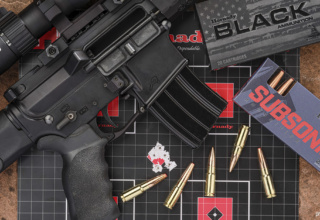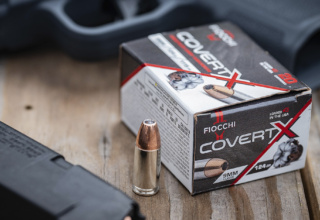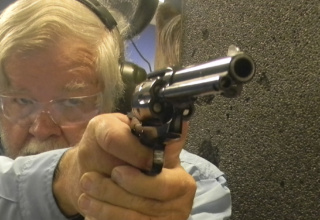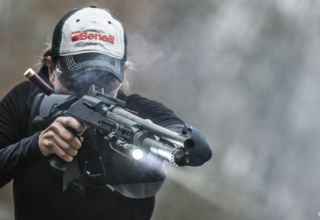For an all-around defensive, hunting, and survival rifle, Springfield’s latest .308-caliber semi-auto moves to the top of this evaluator’s list.
by Bob Campbell
While young shooters regard Springfield Armory, Inc. as an old-line firearm company, I watched Springfield grow from an upstart concern that began in 1974. Today, Springfield enjoys a hard-won reputation for excellent service-grade gear. Springfield quality is a factor, taking some of the uncertainty out of an engagement.
When Springfield introduced the Saint rifle amid much fanfare, I was excited to test the AR-platform firearm from one of my favorite manufacturers. The new AR-15, entering an already crowded market, had to offer a lot for the money, and the Saint did just that. If you pay less for a rifle, corners have been cut. If you pay more, be certain of what you are getting because it may not be much.
Recently, Springfield introduced an AR-10 .308 Winchester version of the Saint Victor. This rifle grabbed my attention, and after a reshuffling of assets and a fair trade, I had the rifle in hand.
In common with the company’s vaunted M1A rifle, the Saint Victor comes in several grades. The Saint Victor is a bit above standard, but not quite up to the Springfield Edge model in terms of features. The model is easily upgraded with aftermarket parts, like any AR, but that’s another story.
There are no surprises in the Saint Victor’s layout and design. The Saint Victor is a direct gas impingement design like mos AR rifles. The AR-10 Saint Victor uses MagPul magazines. One twenty-round magazine is supplied with the rifle along with a compartmentalized carrying case.
The barrel is the standard Springfield chrome moly job, coated with Melonite. Melonite-coated firearms have proven resistant to corrosion and clean easily. The barrel features a competent muzzle brake. I consulted with my son, a rifle-builder formerly employed by a major maker (not Springfield). He noted that his custom-grade rifles would be set up the same way. He feels the mid-length gas system is reliable and appropriate for the sixteen-inch barrel on the Springfield Saint Victor. The barrel boasts a 1:10 twist. The barrel isn’t a heavyweight for several reasons, although it is plenty accurate.
The Springfield Saint Victor weighs seven pounds, thirteen ounces with an empty magazine. This is light enough to use as a hunting rifle or an all-around tactical / go anywhere / do anything rifle for those who prefer a .308 chamber. It features standard Bravo Company Gunfighter furniture.
An interesting modification to the AR-type rifles is the Springfield Accu-Tite device accessed by removing the grip. This device eliminates looseness in the upper and lower receiver and may be adjusted, although you probably won’t need to under normal use. I like this feature a lot.
While Springfield engineers did their best to keep the weight of the .308 rifle as light as possible, they did not cut the area available to mount lights and optics. The Springfield will accept red dots, magnified optics, and backup sights as well as any rifle. The forend also offers generous mounting space. The rifle is supplied with open sights, allowing the shooter to develop elemental marksmanship skills.
The Saint Victor includes an adjustable gas block. Supplied metering screws are color coded, easy to change, and allow you to modify the gas system for light to heavy loads. The FN FAL rifle famously featured an adjustable gas system. A dirty rifle might need more gas, and there isa chance of off-spec rounds as well. I fired a wide range of loads from 125 to 220 grains in handloads and factory loads without any problem. None were particularly light or heavy. Gas adjustment is a good feature for the handloader. I can see working up .30-30 level loads for easy practice; however, since you use the supplied T-handle to adjust the gas block from the muzzle end, you probably will not be able to use it from the bench at a public range. The gas adjusting valves are different sizes but there is also a single, highly adjustable gas screw as well.
From my testing, I concluded that the gas block needs no adjustment when shooting factory loads. For advanced shooters, they are good to have. Ditto should you wish to run a suppressor.
The charging handle, trigger, safety, magazine catch, and bolt release are all in the same location as any other AR-type, so I hit the ground running on handling. The rifle features Springfield’s nickel boron-coated trigger. This is a flat-faced, single-stage trigger. It pulled seven pounds at the start of the testing before settling into a nice and smooth six pounds. I prefer something a bit lighter, although most shooters will find this to be a good weight. With .308 recoil and a light trigger, you just may double a trigger if you are not careful. Doubling is firing two rounds when you meant to fire one. It takes time and accomplishment with the trigger to prepare for a lighter trigger press.
Just the same, I ordered and installed a Wilson Combat TTU trigger. The TR-TTU-M2 two-stage trigger isn’t difficult to install and breaks at a clean 4.1 lbs. The TTU features a 1911-like half-cock notch. But I am getting ahead of myself.
The gas system and the buffer recoil spring and weight combo seems well-tuned for .308 recoil. As a man who doesn’t fire many rifles but concentrates on a handful of very good rifles, I feel I got the most from the Saint Victor.
In initial handling, the stock—a Bravo Company Gunfighter—exhibited no rattle. The six positions were positive and tight. I like the fit and the tightness. For my taste, the Gunfighter grip has a more pleasant angle than the standard AR 15 grip profile.
I fired the rifle first with Winchester 7.22x51mm white box ammo, adding a few SIG Sauer Elite 168 grain loads in the mix. Twenty-five yards is a good distance to do preliminary zeroing. Out of the box, the rifle hit six inches low with the factory iron sights yet the group was tight.
Next, I installed the TRUGLO Ignite 30mm Red Dot. The Ignite is a middle-of-the-road optic in price and I have enjoyed good results with it. You can buy them for $120-150, and it is worth the price. This red dot is fast and easy to sight in. It comes with both high and low mounts and an automatic off feature, plus easy-to-adjust illumination buttons.
With the Ignite mounted, things got lively. I was busting steel plates well past 60 yards. I also fired a magazine of handloads with the 168-grain Nosler bullet and H4895 powder. The rifle isn’t as fast to lay down fire as the 5.56mm, but you are delivering a larger bullet with plenty of penetration.
I fired several Hornady Critical Defense 155-grain loads specially designed for defense use with the .308. This is an advanced load. Results were good and the steel plate took a beating. Magazine changes are not as fast with the AR-15 as the MagPul magazines are tighter in the magazine well, but you may replenish the magazine supply quickly with practice.
I have done a little firing at 100 yards with the red dot. A 2 MOA, the dot isn’t ideal for 100-yard work, although I was busting dirt clods on the berm on a regular basis and punishing the steel plates. One-hundred and twenty brass cases later, the rifle had never failed to feed, chamber, fire, or eject.
There are some of us who prefer a .308 because, when you hit something with the .308, it tends to “stay hit.” There is persistent violence on this planet and life is less pleasant when we encounter those with violent tendencies. The Saint Victor represents a logical progression for me in emergency rifles, beginning with a Winchester .30-30 many years ago, progressing to the Springfield M1A SOCOM, and now the Saint Victor. The Saint Victor hits hard, hits fast, and offers enough power for hunting game as well as for personal defense.
While the Saint Victor is a viable all-around protection rifle, only planning makes the reality. You will require training and practice but, in the end, you have a 300-yard rifle for the worst case and a short-range fighting rifle all in one.
So, the Saint Victor is a credible and diverse performer with civilized amenities. How would it fare as a hunting rifle? After all, I was intent on replacing not only the M1A but also my bolt action rifle as a go-anywhere, do-anything firearm. As it turned out, the Saint Victor demanded no compromises.
This time, I added an optic that is good to go for hunting well past 200 yards. I used the Warne R.A.M.P. tactical mount—a multi-sight, rock-solid cantilever design well-suited to the Saint Victor. With the centerline of the scope 1.43 inches above the receiver, I was able to form a good cheek weld. The scope of choice: a Leupold VX-6.
The 1-6 x 24mm scope is ideal for use on an accurate self-loading rifle. The Fire Dot duplex reticle is illuminated, and the range of adjustment makes for fast acquisition of the target at modest range. By maxing out magnification, you may connect at a long 300 yards.
I settled down to benchrest the rifle. Results were good with a range of loads. Groups of less than two inches for five shots were average. This is a good standard for the average AR-10 .308. It is as good as all but a match grade M1A1 rifle, in my book. As I gained trigger time and later fitted the Wilson Combat TTU trigger with a 4 lb., 1 oz. pull, things improved dramatically. Although I am stuck at a 1.5 inch average with most loads, I have fired a single three-shot group at 100 yards that went .9 inches. That is excellent and more accuracy than expected. (The load was the advanced Federal Ascent 175-grain cartridge.)
Overall, I am quite pleased with the Springfield Saint Victor. There has been an investment in time, optics, and ammunition—not to mention trigger time—to wring the best results from the rifle, but it has all been worthwhile. This is a great modern sporting rifle. It will take game or save your life.
Springfield Saint Victor .308 Specifications
- Caliber: .308 Win.
- Capacity: 10- or 20-round Magpul
- Barrel: 16 in. Melonite-coated chrome-moly vanadium; 1:10 twist
- Overall Length: 34.5–37.75 in. depending on stock adjustment
- Weight: 7 lb. 13 oz.
- Furniture: Bravo Company Gunfighter grip and Gunfighter stock
- Trigger: 6 lb. pull after break in; flat-face single-stage; nickel boron-coated
- Sights: Fixed UTG flip-up front and rear, supplied
- Price: $1,399 MSRP
Accuracy Testing (with Leupold scope and original trigger), three-shot groups @100 yds.
- Black Hills, 175-grain SMK; 2590 fps; 1.75 in.
- Hornady Critical Defense; 2622 fps; 1.8 in.
- Winchester 168-grain BTHP; 2558 fps; 1.9 in.
- Federal Premium 180-grain Partition; 2480 fps; 2.0 in.























